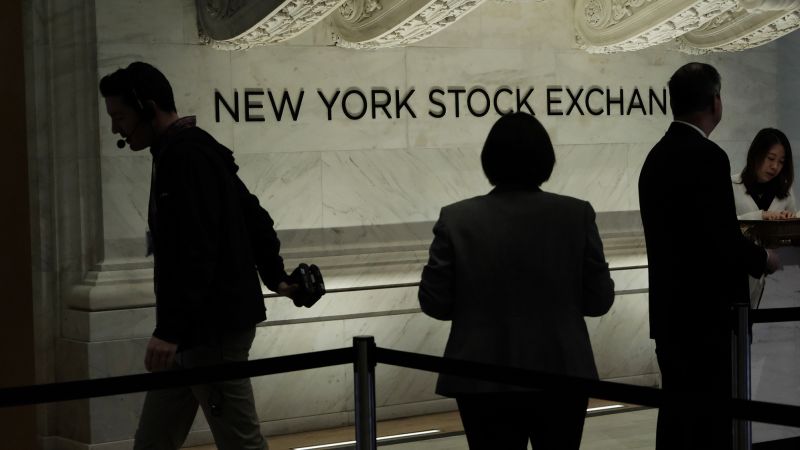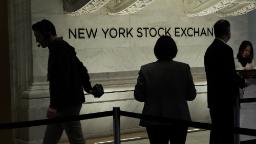

A version of this story first appeared in CNN Business’ Before the Bell newsletter. Not a subscriber? You can sign up right here. You can listen to an audio version of the newsletter by clicking the same link.
New York
CNN
—
Everyone seems to be in a bit of a debt bind at the moment: The US government has run out of credit to spend, high inflation and interest rates have taken a big bite out of debt-laden tech companies that expected pandemic-era growth to continue and US credit card debt reached nearly $1 trillion in the fourth quarter of 2022, according to TransUnion.
Last year was bad for credit on all counts as Covid-zero policies in China, Russia’s war on Ukraine and the associated energy crisis and high inflation led to turbulent markets, pushed up borrowing rates and slowed the global economy.
Economists are hoping that this year brings better news, but 2023 is unlikely to provide the clean break investors are hoping for. Governments have diminishing fiscal options to deploy after piling on debt during the pandemic and individual borrowers face a prolonged period of elevated interest rates.
Profit pressures on corporate borrowers, meanwhile, are intensifying at an especially rapid pace as business costs remain elevated while consumer demand wanes amid the prospects of an economic downturn.
High borrowing costs and an uncertain economic outlook mean that companies are trading in the prospect of rapid growth for smaller debt loads. Fourth-quarter earnings reports show that the pace of debt reduction accelerated to -1.6% for the year, from -0.9% in the third quarter, according to Bank of America.
But businesses that don’t have cash to pay down debt loads may face the music in 2023. Economists at S&P Global Ratings forecast that speculative-grade (perceived to have a lower level of credit quality compared to more highly rated, investment-grade, companies) corporate default rates in the US and Europe will double this year alone.
So are we on the brink of a corporate credit crisis?
Before the Bell spoke with Ruth Yang, managing director and global head of thought leadership at S&P Global Ratings to discuss what lies ahead for the corporate credit market.
Before the Bell: What’s your big picture view of the credit economy right now?
Ruth Yang: There’s no easy way out, we have a very narrow pathway forward. If we have a shallow and short recession, then the risk for defaults is also shallow and short. But if we have a longer recession — even if it’s shallow — and growth continues to slow, we’re going to see defaults start to rise and credit markets struggle.
Corporations still have cash cushions on their balance sheets but they’re getting eaten away, we’re running out of time and the pathway is narrowing. As it narrows exogenous macro shocks present larger risks to the credit markets. It could be the destabilization of crypto, or the tension between energy security and the cost of energy and climate change or US-China relations and supply chain problems.
All of these things are going to come at costs and the impact is really magnified because we don’t have a lot of margin for error. We don’t have a lot of room to maneuver and we have a lot at risk.
How are you seeing credit headwinds playing out in investment strategies?
‘Higher for longer’ interest rates isn’t just about borrowing costs. Something I’ve noticed is that it’s also impacting funding strategies in general. Private equity investors and others are no longer as focused on total return and are less willing to fund companies that are cash-flow negative in the short term. They’re going to be a lot more focused on cash-flow-positive companies across the board. We think that will change sector-based investment strategies — technology and health care are notoriously cash-flow negative and will have more trouble finding funding.
Who will lead the way in these possible funding changes?
Private equity fuels an enormous part of our economy and the ability to get funding is going to lead the way in corporate earnings reports. The maturity wall for debt is still a few years down the road but if we’re still in a ‘higher for longer’ state in two or three years we’re going to have to fundamentally change how we fund companies. The business models of companies that are able to raise funds will also change. There will be slower growth with thinner margins and that’s going to change how people look at their investment opportunities.
▸ Investors who find themselves infatuated with inflation rates will receive a nice Valentine’s Day treat on Tuesday with the release of January’s Consumer Price Index. Last week, Federal Reserve Chairman Jerome Powell made headlines and lifted markets as he said that 2023 would bring more disinflation.
“We expect 2023 to be a year of significant declines in inflation. It’s actually our job to make sure that that’s the case,” said the central bank chief in a question-and-answer session at the Economic Club of Washington, D.C.
Wall Street will watch closely to see if prices continue to drop in the first inflation report of the year and if sticky service inflation finally begins to deflate.
Analysts are predicting some bad news, however. They forecast that headline CPI increased by 0.4% month over month in January, according to Refinitiv data. That would be an acceleration from the recent pace.
That outlook mostly reflects an increase in energy prices, driven by higher gasoline prices. Data from AAA shows that gas prices rose by 4.4% in January.
Analysts from Bank of America also predict that core services likely rose by 0.5% from December, owing largely to a 0.7% increase in shelter costs.
▸ The Producer Price Index, which measures the change in input for companies, is due out on Thursday. When producers face input inflation, the increases in their production costs are passed on to retailers and consumers — so this data is considered a leading indicator of inflation.
Price increases upstream from the consumer during January are also expected to have accelerated from December. The monthly core number is forecast to rise to 0.3% from 0.1%, with the core year-on-year number rising to 5.7% from 5.5%, according to Refinitiv.
▸ Nearly three-quarters of S&P 500 companies have released fourth-quarter earnings and the season is winding down, but there are still some big names reporting this week.
Palantir and Avis report on Monday.
On Tuesday Coca-Cola, Airbnb, Marriott and GoDaddy report.
Wednesday brings earnings news from Cisco, Shopify, AIG, Kraft Heinz, Fidelity, Biogen and Roblox.
DoorDash, Paramount Dropbox, Hasbro and DraftKings come Thursday.
The week closes out with Deere & Company, AutoNation and AMC on Friday.
If you bought booze ahead of the Super Bowl on Sunday, you may have gotten a better deal if you skipped beer and went straight for the hard stuff.
Beer prices this year have jumped 11% from a year earlier, while wine and spirits are up 4% and 2%, respectively according to a new Wells Fargo Super Bowl Food Report.
Party guests may have also enjoyed the switch. Spirits were more popular than beer last year for the first time ever, according to a new Distilled Spirits Council of the United States (DISCUS) report last week.
Spirits sales rose in the United States (for the 13th straight year) in 2022, and now represent 42.1% of the total US alcohol market share. This is the first time spirits supplier revenues have surpassed beer, which holds a 41.9% market share.
Driving the growth were increased sales of American whiskey and tequila.
“More than 60% of the spirits sector’s total revenue was from sales of high-end and super-premium spirits, mainly led by Tequila and American Whiskey,” said Christine LoCascio, DISCUS chief of public policy and strategy in a statement last week. “While many consumers are feeling the pinch from inflation and reduced disposable income, they are still willing to purchase that special bottle of spirits, choosing to sip a little luxury and drink better, not more.”
Still, vodka led the way in the United States, with $7.2 billion in sales last year, about the same as in 2021.
But it appears Wall Street likes to invest sober — those gains haven’t shown up in the broader market just yet. Constellation Brands (the company behind Svedka Vodka, Casa Noble Tequila and High West Whiskey), Brown-Forman (Jack Daniel’s, Herradura, Woodford Reserve, el Jimador and Finlandia) and Diageo (Johnnie Walker, Crown Royal, J&B, Smirnoff, Baileys, Ketel One and Captain Morgan) are all under-performing the S&P 500 so far this year.
